Common Tree Troubles of Summer
Almost every tree species has one or more problems that shows up in summer. That would make it almost impossible to mention them all, but I’ve accumulated the ones about which I’m asked most often. Take a look through this list.
• Webworms in pecans, walnuts, persimmons, etc. These are larvae of moths that move from neighborhood to neighborhood. They form webs near the ends of the trees’ branches. Webs that are grapefruit-sized one day may be as big as pigs five days later. Spraying high into trees has never been successful for me, so I just prune these out with a long-handled pole pruner. By getting to them early, damage to the branch is minimal.

Webworms quickly devour foliage of pecans and other tree species.
• Bagworms in redcedars, Italian cypress, bald cypress, arborvitae and other small-needled conifers. Watch closely for these invaders, because they can kill these types of plants quickly and completely. Initially the small bags will be only a quarter-inch long, but as they feed and pull the bags behind them, the bags will grow to be pinkie-sized. Almost any insecticide will control them while they are actively feeding. Once they tie the bags to the twigs and stop feeding, there is no product that will help with them. Eliminate them the first day that you see them! Better yet, apply a systemic insecticide in mid- to late May to avoid serious feeding and damage.
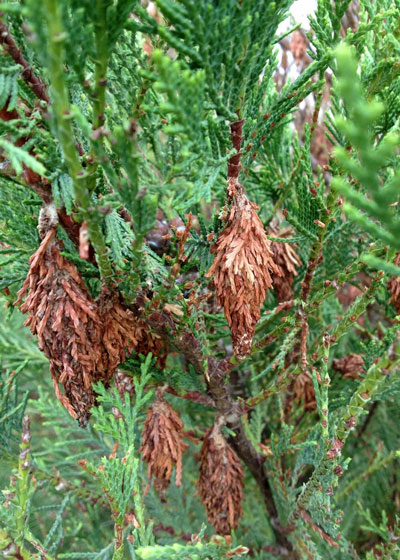
Bagworms attack redcedar and other coniferous needles.
• Aphids, scales and other honeydew-secreting pests. These coat the leaves of pecans, elms and crape myrtles, among many others, and the excess honeydew drips onto all surfaces below – including your patio furniture, cars, walks and decks. Systemic insecticides applied several weeks prior to the normal infestation dates work best, but contact insecticides sprayed into the trees will also work.
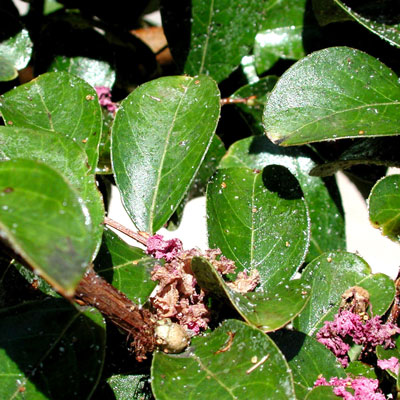
Aphids congregate on foliage of crape myrtles, pecans and others, then leave honeydew behind.
• Lace bugs on bur oaks, sycamores, elms and other trees. These transparent insects are difficult to see with their clear, cellophane-like wings. But they turn leaves mottled tan in the process, and they, too, leave extensive honeydew coatings beneath the trees’ canopies. Lace bugs are disfiguring but not highly damaging.
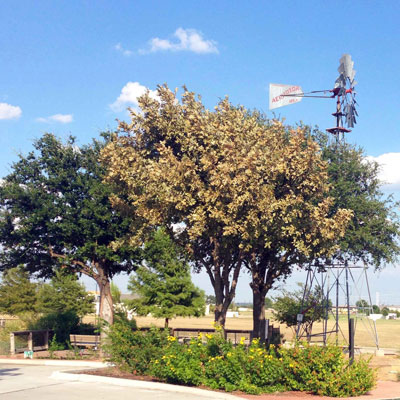
Lace bugs cause leaves of bur oaks and other trees to turn tan and apparently lifeless.
• Older leaves yellowing and dropping. Some might assume this to be iron deficiency, but it’s not. Iron chlorosis causes leaves to be yellowed with dark green veins, and the yellowing is most prominent at the outer ends of the branches. The leaves do not fall. By comparison, trees that get too dry (or that just can’t take water in fast enough to meet their needs) will jettison lower, older leaves. They’ll turn yellow, and a few days later they’ll be all over the ground. Try soaking those trees deeply to see if it abates, but many fast-growing types (mulberries, cottonwoods, catalpas, etc.) are just going to do this every summer, no matter how much you care for them.
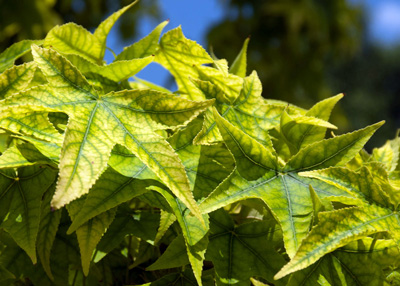
Sweet gum shows iron chlorosis symptoms.
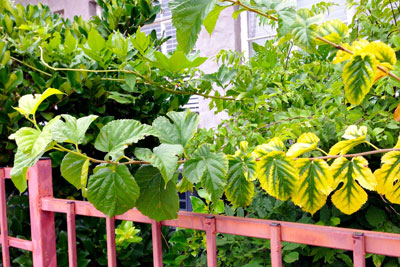
Mulberry leaves will turn yellow due to hot, dry weather ahead.
• Sudden death of lacebark elms, silver maples and other species due to cotton root rot. CRR is a soil-borne fungus that has caused the end of the cotton industry in many parts of the state. It’s only an issue in areas with alkaline soils, and infested plants go from green and growing to dead in just a matter of one or two weeks. There are no means of preventing it or curing it. It’s best to replant with resistant species like oaks, cedar elms, pecans, junipers and magnolias. Ask for help at your local independent garden center – someone well familiar with your exact situation.

Cotton root rot fungus has killed this lacebark elm.
